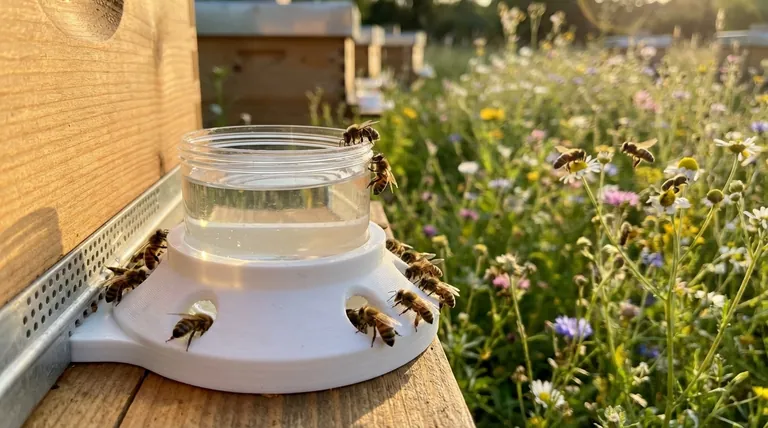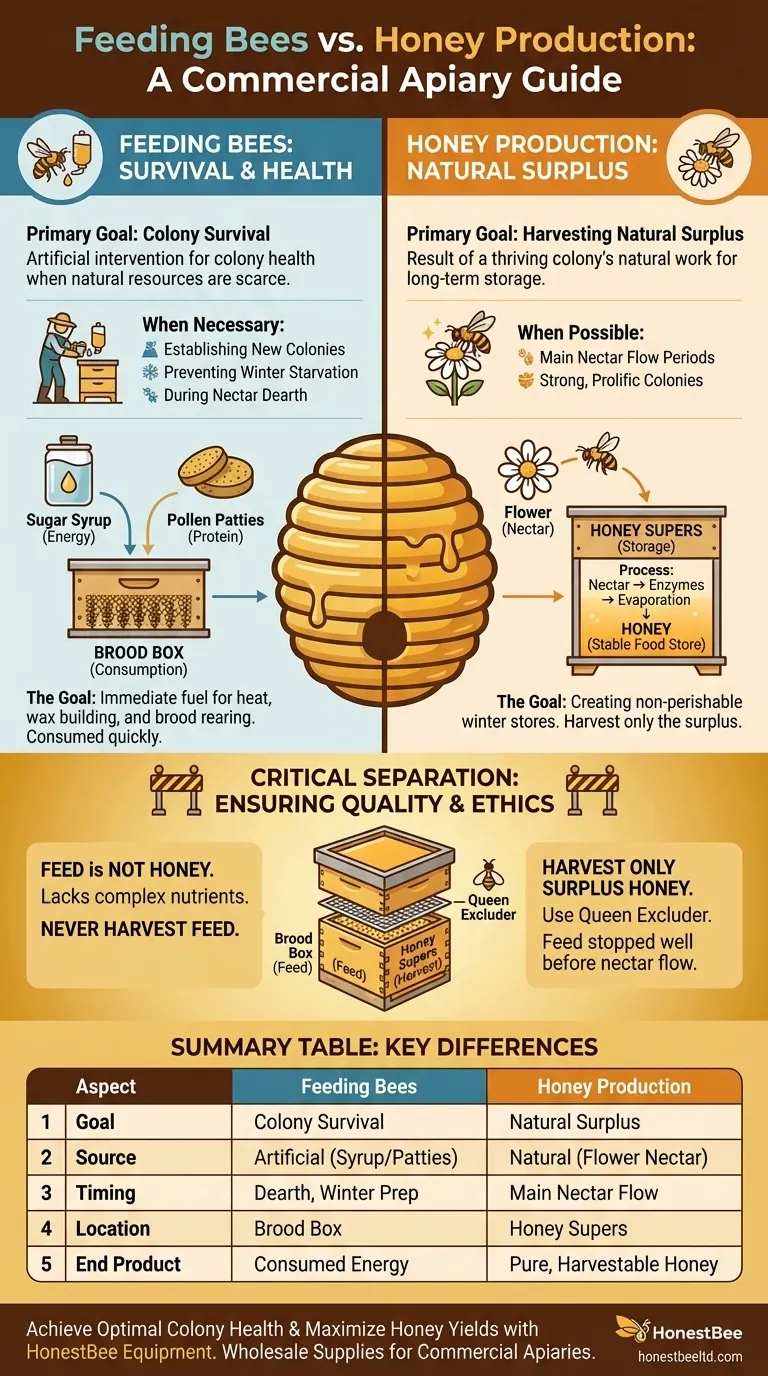In beekeeping, feeding bees and producing honey are two entirely separate activities with opposing goals. Feeding is a direct intervention by the beekeeper to ensure a colony's survival by providing an artificial food source, like sugar syrup. Honey production is the natural process of bees foraging for flower nectar and converting it into a stable, long-term food store for themselves.
The core distinction is one of purpose: feeding is a management tool for colony health and survival, while honey production is the result of a thriving colony's natural work. Ethical beekeepers only harvest the surplus honey, never the supplemental feed.

The Purpose of Feeding: A Matter of Survival
Feeding a honeybee colony is a deliberate act of support. It is done not to create a product for humans, but to fuel the colony's engine when natural resources are scarce.
When Feeding is Necessary
Beekeepers provide supplemental feed in a few critical situations:
- Establishing New Colonies: A newly installed package or nuc of bees has no food stores and needs immediate energy to begin drawing out comb and raising brood.
- Preventing Winter Starvation: In late fall, if a colony hasn't stored enough honey, a beekeeper will feed them heavy syrup to ensure they have enough food to survive the cold months.
- During a Nectar Dearth: A "dearth" is a period when no nectar-producing flowers are in bloom, often in late summer. Feeding prevents the colony from consuming all its winter stores prematurely.
What Bees are Fed
The most common feed is a simple sugar syrup—a mixture of white cane sugar and water. For stimulating brood production, beekeepers may also provide pollen patties, which are a protein substitute. These feeds provide immediate energy and nutrition for consumption.
The Goal: Fueling the Colony
Think of supplemental feed as immediate fuel. The bees consume it directly to generate heat, build wax, and raise young. It is stored in the main living quarters of the hive (the brood box) and is used up quickly for day-to-day operations.
The Process of Honey Production: Nature's Surplus
Honey is not simply stored nectar or sugar water. It is a complex, natural product manufactured by the bees themselves for the specific purpose of long-term storage.
From Nectar to Honey
Foraging bees collect nectar from flowers and store it in a special "honey stomach." Back at the hive, they pass this nectar to other bees, who add enzymes that begin breaking down complex sugars into simpler, more stable ones.
The bees then deposit this processed nectar into wax honeycomb cells. They fan the cells with their wings to evaporate excess water content until it reaches about 18% moisture, creating the thick, stable substance we know as honey.
The Goal: Creating Winter Stores
Bees make honey for one reason: to create a non-perishable food source to survive the winter and other periods of scarcity. A strong colony is prolific and will create far more honey than it needs, storing this surplus above their living quarters.
Understanding the Critical Separation
A responsible beekeeper's primary job is to keep these two processes—feeding and honey harvesting—strictly separate. This is the foundation of producing pure, high-quality honey.
Why Feed is Not Honey
Sugar syrup lacks the complex sugars, enzymes, pollen, and micronutrients from nectar that make honey what it is. It is a simple carbohydrate for quick energy. If bees were to store it, it would not be honey; it would just be stored sugar water.
The Golden Rule: Never Harvest Feed
Ethical beekeepers only harvest honey from the surplus stores. They use a physical barrier called a queen excluder to separate the queen's living area (the brood box) from the honey storage boxes (honey supers).
Feeding occurs only into the brood box and is stopped well before the main nectar flow begins. Honey supers are only added to the hive after feeding has ceased and the bees are actively bringing in natural nectar. This management technique ensures the harvested product is pure honey, not adulterated syrup.
Making the Right Choice for Your Goal
Understanding when to feed and when to prepare for honey production is a key skill for any beekeeper. Your actions should be dictated by the colony's needs and your specific goals.
- If your primary focus is ensuring colony survival: Feed your bees during a nectar dearth, when establishing a new colony, or in the fall to build up winter stores.
- If your primary focus is harvesting pure honey: Stop all feeding well before the main nectar flow begins and only add your honey supers once the bees are actively foraging on flowers.
Knowing this fundamental distinction is the cornerstone of responsible and sustainable beekeeping.
Summary Table:
| Aspect | Feeding Bees | Honey Production |
|---|---|---|
| Primary Goal | Colony survival and health | Harvesting natural surplus |
| Source | Artificial (e.g., sugar syrup) | Natural (flower nectar) |
| Timing | Nectar dearth, new colonies, pre-winter | Main nectar flow periods |
| Location in Hive | Brood box | Honey supers (above brood box) |
| End Product | Consumed by bees for energy | Pure, harvestable honey |
Achieve optimal colony health and maximize your honey yields with the right equipment. HONESTBEE supplies commercial apiaries and beekeeping equipment distributors with durable, high-performance beekeeping supplies. From reliable feeders to efficient honey supers, our wholesale-focused operations provide the tools you need to master the balance between feeding and production. Contact our experts today to discuss your apiary's needs and ensure a successful, sustainable season.
Visual Guide

Related Products
- HONESTBEE Entrance Bee Feeder Professional Hive Nutrition Solution for Beekeeping
- Professional Hive Top Bee Feeder for Beekeeping
- Professional Hive Front Entrance Bee Feeder
- HONESTBEE Professional Entrance Bee Feeder Hive Nutrition Solution
- Classic Boardman Entrance Bee Feeder Hive Front Feeding Solution
People Also Ask
- What are the different types of honey bee feeders? Choose the Right Feeder for Your Hive
- What is an entrance feeder? A Guide to Its Simple Design and High Robbing Risk
- Are entrance feeders good for bees? Prioritize Hive Health Over Convenience
- How does the entrance feeder method work? A Guide to Simple But Risky Hive Feeding
- How to make an entrance feeder for bees? A DIY Guide for Safe & Effective Feeding



















